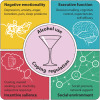Advances in the science and treatment of alcohol use disorder
- PMID: 31579824
- PMCID: PMC6760932
- DOI: 10.1126/sciadv.aax4043
Advances in the science and treatment of alcohol use disorder
Abstract
Alcohol is a major contributor to global disease and a leading cause of preventable death, causing approximately 88,000 deaths annually in the United States alone. Alcohol use disorder is one of the most common psychiatric disorders, with nearly one-third of U.S. adults experiencing alcohol use disorder at some point during their lives. Alcohol use disorder also has economic consequences, costing the United States at least $249 billion annually. Current pharmaceutical and behavioral treatments may assist patients in reducing alcohol use or facilitating alcohol abstinence. Although recent research has expanded understanding of alcohol use disorder, more research is needed to identify the neurobiological, genetic and epigenetic, psychological, social, and environmental factors most critical in the etiology and treatment of this disease. Implementation of this knowledge in clinical practice and training of health care providers is also needed to ensure appropriate diagnosis and treatment of individuals suffering from alcohol use disorder.
Copyright © 2019 The Authors, some rights reserved; exclusive licensee American Association for the Advancement of Science. No claim to original U.S. Government Works. Distributed under a Creative Commons Attribution NonCommercial License 4.0 (CC BY-NC).
Figures

References
-
- World Health Organization, Global Status Report on Alcohol and Health 2018 (2018); www.who.int/substance_abuse/publications/global_alcohol_report/en/.
-
- Substance Abuse and Mental Health Services Administration, Key substance use and mental health indicators in the United States: Results from the 2017 National Survey on Drug Use and Health (HHS Publication No. SMA 18-5068, NSDUH Series H-53) (2018); www.samhsa.gov/data/.
-
- Sacks J. J., Gonzales K. R., Bouchery E. E., Tomedi L. E., Brewer R. D., 2010 national and state costs of excessive alcohol consumption. Am. J. Prev. Med. 49, e73–e79 (2015). - PubMed
-
- American Psychiatric Association, Diagnostic and Statistical Manual for Mental Disorders (American Psychiatric Publishing, ed. 5, 2013).
-
- Grant B. F., Goldstein R. B., Saha T. D., Chou S. P., Jung J., Zhang H., Pickering R. P., Ruan W. J., Smith S. M., Huang B., Hasin D. S., Epidemiology of DSM-5 alcohol use disorder: Results from the National Epidemiologic Survey on Alcohol and Related Conditions III. JAMA Psychiat. 72, 757–766 (2015). - PMC - PubMed
Publication types
MeSH terms
Substances
Grants and funding
LinkOut - more resources
Full Text Sources
Other Literature Sources
Medical

